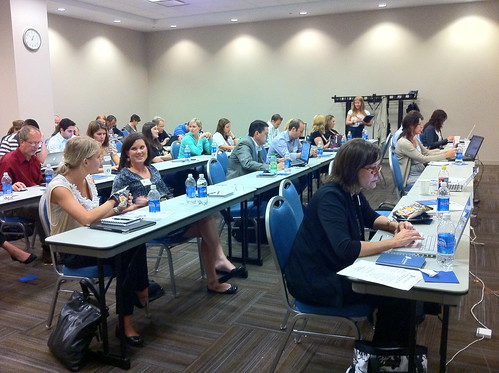When you’re speaking, be it on stage, in a boardroom, or even with your colleagues at the water cooler, you’re likely to notice different levels of attention and engagement. I’ve noticed roughly 5 zones of attention and indicators about where people are:
- I don’t care: The audience simply doesn’t care. They don’t want to be there.
- I’ve already got it: The audience is bored by hearing something they’ve heard before.
- I get it: The audience is excited and engaged by what you’re saying.
- I think I get it: The audience is excited but confused.
- I don’t even understand what’s being said: The audience is frustrated.
When you’re reading the room (see this previous post for the basics), pay attention to these key, visible indicators in combination:
- Note taking: Note the pace at which people are taking notes. How fast are they typing or writing? How much are they writing?
- Side conversations: Note the number of side conversations people have, and whether the interactions are quick check-ins (“what did he say”) vs. full conversations.
- Posture: Disengaged audiences tend to slouch or recline. Engaged audiences lean forward or sit straight up, depending on how they’re taking notes. Frustrated audiences hunch forward but aren’t taking notes.
The 5 general zones and their corresponding indicators map out like this:
| State | I don’t care | I’ve already got it | I get it | I think I get it | I don’t even understand what’s being said |
| Note taking | Low | Low | High | Medium | Low |
| Side convos | High | High | Low | Medium | High |
| Posture | Disengaged | Disengaged | Positive engaged | Positive engaged | Frustrated |
Your task as a speaker, as a marketer, is to keep people squarely in “I get it”. Most everyone in a meeting or talk starts out there. Watch for indicators that people have strayed too far to “I’ve already got it” or “I think I get it”, as those are warning signs you’re not aligned with what they can handle.
You might also enjoy:
- You Ask, I Answer: AI Music Collaborations and Copyright?
- Mind Readings: Hacking Social Media Algorithms
- You Ask, I Answer: Legality of Works in Custom GPTs?
- Mind Readings: What Makes A Good Conference/Event?
- Mind Readings: Most Analytics Data is Wasted
Want to read more like this from Christopher Penn? Get updates here:
 Take my Generative AI for Marketers course! |



Leave a Reply